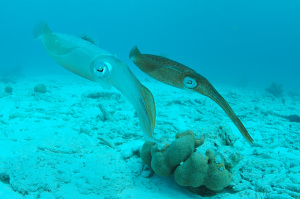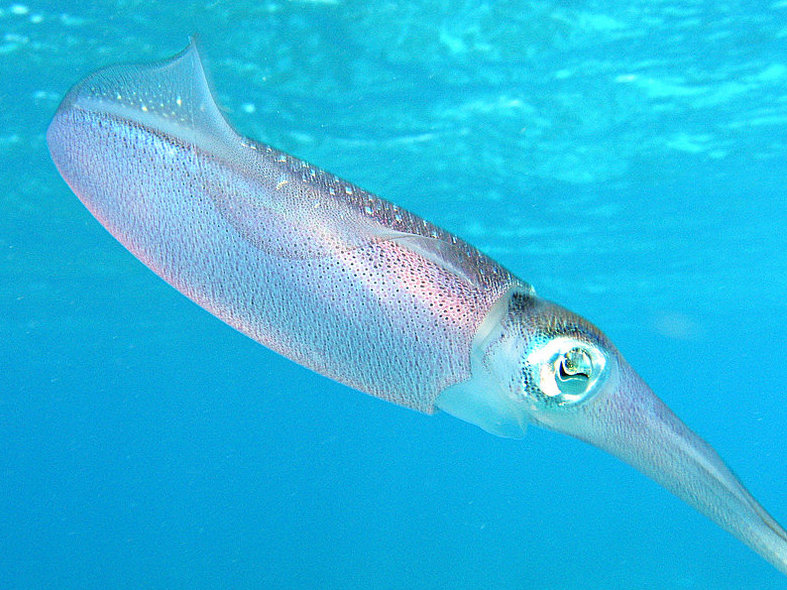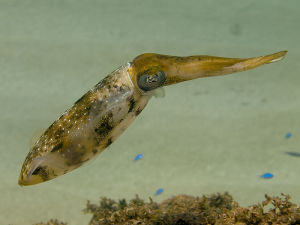In this article I’m going to not tell you about cuttlefish.
We had dinner with Dave, Nancy and their daughter Sidney last night, here on our Caribbean coastline in Mexico, and all of us were remarking on the cuttlefish we’d been seeing out on the reef lately. Cuttlefish are beautiful and enchanting little creatures, about nine inches long, with graceful tentacles hanging from their face, huge, mesmerizing eyes with W-shaped pupils, and an apron-like fin all the way around their body that undulates like a dust ruffle to propel them around. They’re inquisitive, and whenever Susan and I come across a few, they will usually stay with us for a while as we swim. Caribbean reefs are just full of beautiful and mysterious creatures, but Susan and I were becoming especially fond of these cuttlefish.
The specific question that had been intriguing Dave was why they always seem to occur in threes. Susan and I had noticed this too. You’ll see them in ones and twos now and then, but usually threes. Fascinating. I started digging. What I learned was just amazing. Here’s what I found out:
Cuttlefish don’t occur in the Caribbean.
“D’oh!” I said to my laptop monitor, and smeared my hand down my face. It shows you how much I still have to learn about my new ecosystem.
No one’s sure why they don’t occur in the Caribbean. Cuttlefish have one of the strangest distributions you can imagine. They’re in the Atlantic and they’re in the Pacific—it’s not like they’re not in our oceans. They’re on the European coastlines and the African coastlines and the Asian coastlines and even the Australian coastlines, but they do not touch the Americas. The best guess is that they evolved in the old world, and then the big oceans got too cold and deep for them to cross, being warm water and shallow water creatures. There’s a part of me that’s somewhat surprised that they haven’t managed to get introduced somehow, and start throwing things out of whack like the lionfish is doing.
What we’ve been looking at is called the Caribbean reef squid (Sepioteuthis sepioidea), and they look a lot like a cuttlefish—in fact, their scientific name alludes to the resemblance (cuttlefish being the order Sepiida).
Well, they may not be cuttlefish, but they are cephalopods, and cephalopods are my second-favorite mind-blowing organisms after jellyfish, so Dave, don’t be disappointed yet. Trust me, Caribbean reef squids are fall-down-and-slap-the-ground amazing. For one thing, they can fly. More on that in a bit.
Cephalopods are the octopi, squid, cuttlefish and nautiluses. They are a mash-up of legacy evolutionary traits and astonishing innovations not seen anywhere else. They’re shellfish (mollusks) who took a bizarre evolutionary turn, and I hugely enjoy bizarre evolutionary turns, because they remind us that life on this planet is not following any grand scheme, and neither are we. (We became us by accident too, believe me—and by the way, we only made it by the skins of our teeth.)
Cephalopods can change color in a flash, by conscious control, using muscular contraction and pigment cells called chromatophores. Their colors shimmer and dance across their bodies as you watch. They can also change their texture instantaneously, going from silky smooth to rough and spiky in a blink, and they can change their shape to mimic other creatures or objects. All that remains of their shell (ignoring the nautilus for now) is a beak a lot like a parrot beak, which is dead center between their tentacles (actually called arms) which they use to crunch the shells of their prey. A large species of octopus can have roughly the intelligence of a dog or a cat, depending on who you talk to, and squids and cuttlefish have been studied less, but appear not to be far behind.
That intelligence level is not bad for a shellfish, and it fascinates scientists, because their brains and nervous systems are so radically different from our own, or from any mammal, or even bird or reptile. They are such different creatures that in many ways intelligence in cephalopods can be considered a case of convergent evolution. That’s where two species independently arrive at a similar solution to a problem. Two thirds of their neurons are not even in the brain, but are out in the arms, which have a lot of autonomy in what they do. It is not a centralized system like ours, and if you watch an octopus forage in a rocky reef, you’ll see this design at work—they are reaching into numerous crevices and hidey-holes simultaneously. Clearly they’re thinking about eight things at once.

-
Two Caribbean Reef Squids (in different moods)
Photo by Clark Anderson CC BY-SA 2.5
You can put a crab in a jar, and an octopus will figure out how to unscrew the lid and get it out. You can put the octopus in the jar, and he’ll figure out how to open it from the inside. I don’t know if they’ve tried any of this with a squid or a cuttlefish. An octopus named Otto in the Sea Star Aquarium in Coburg, Germany, got annoyed at the 2,000-watt spotlight that was left on all night above his tank, so he started hitting that thing with jets of water and shorting the place out. I’m not making this up. It threw the aquarium into crisis. Everything went down including the pumps, and it threatened the lives of all the creatures in all the tanks, and it happened every night. They had to stake the place out to figure out what the hell was going on. Otto had other quirks: He was fond of doing something a lot like juggling with the hermit crabs in his tank. He would periodically rearrange everything in it (including the hermit crabs), and he liked to damage the glass by smacking it with rocks. There are other stories from other aquariums. They are talented escape artists, and will leave their tank at night to help themselves to dinner in the crab exhibit, returning to their own tank to eat, and then hiding the remains.
But the thing is, they don’t live long. Sophisticated and intelligent though they are, one or two years is all you get if you’re a cephalopod. It’s called being semelparous—they die immediately after they reproduce, and there’s not a thing you can do about it, and I remember this causing a lot of wet eyes around the Monterey Bay Aquarium from time to time when I was a docent there. These creatures are aware, and they have personalities, and attachments get formed—and then they die.
* * * *
In 2001, Sylvia Macia and her husband Michael Robinson, both marine biologists, were in a boat off Jamaica when a Caribbean reef squid burst out of the water with its fins flared outward and its arms held in a radial pattern, and it sailed to a height of six feet above the water over the course of a thirty-foot flight before dropping back in. They were flabbergasted. Flying fish do this (family Exocoetidae), and it’s a cute trick for predator evasion. There’s no better way to befuddle your pursuer than to blast through a reflective ceiling and vanish. But squid? There had been a few rumors and folk tales, but hell, the ocean is just full of rumors and folk tales. Thor Heyerdahl, who has (and deserves) some respect, reported squid occasionally falling on his raft Kon Tiki. And now and then a biologist will find a squid dead on the floor next to his tank. But those kinds of jumping mishaps can happen with any fish, including a goldfish. This thing was flying.
They sent out a signal to the mollusk community. Reports started trickling in. Maybe this had been witnessed before, but people had assumed they were looking at flying fish. I mean, let’s face it, a flying squid is just not something that has a cubbyhole in your brain. But Macia and Robinson were marine biologists. They knew what a Caribbean reef squid was. Aware of the possibility now, scientists began paying attention with new eyes. The sightings continued to mount. But they were all anecdotal. There were no photographs. There was no proof. The sightings seemed to be very rare, and the flights are so brief, and squid are nocturnal, and catching a flight on film was looking like it might be impossible. They published a paper anyway, in 2004. It was well received. But they still had no proof.
Then, in 2009, a retired geologist named Bob Hulse was on a cruise ship off Brazil. He was an amateur photographer, and he was packing a wildlife camera a lot like Susan’s. He was shooting in burst mode, and at a high resolution, and he captured a handful of “unusual creatures” flying above the water. Though it was not his field of science, he was observant enough to know that he was seeing something weird. He forwarded the shots to the University of Hawaii, and they forwarded them to a scientist named Ronald O’Dor, now at Dalhousie University in Halifax, Canada, and that’s who started working with the best and, at the time, only photographic documentation of flying squid. (They have since been photographed off Japan.) He knew the data he was looking at was gold. The exact interval between the frames was known, and he could calculate the velocity and the acceleration, and get a close look at the body parts. He lit into the project.
What O’Dor is piecing together is amazing. Cephalopods already have the jet propulsion thing dialed in. That was known. They jet around underwater, and blast away backwards as an escape technique. They fill their body (mantle) with water and force it out under great pressure through an organ by their mouth called a funnel. The funnel can be directed, like the nozzle of a guided missle, so they have control. They extend their fins, and hold their arms out stiffly to create another flight surface, and they rocket through the air like little cruise missiles, trailing exhaust streams of water and steering with their flight surfaces. Gliding is too tame a word for what they do. They have a propulsion system onboard, and they have aerodynamic control.
This is breaking science (he presented his paper in 2012), so there is still lots of argument, but O’Dor now believes that they do not fly to escape predators—they do it to travel long distances. They do it to escape the drag of the water. He believes that it explains some long migrations that had always seemed implausible. Using Hulse’s photographs, he calculated that they get five times the speed in the air that he had ever measured in the water from the same propulsive effort. They fly. They fly to get around. But we never knew they did it, because they do it at night, when the birds aren’t out.
Six species of flying squid have now been identified.
The Caribbean reef squid was the first.
* * * *
The Caribbean reef squid communicate with each other through color. Over forty distinct patterns of color and shape have been identified, and that’s just for communication. There are looks scientists call bars, belly stripes, dark arms, yellow flecked, speckled belly. When they’re pissed off, their brow ridge turns metallic gold. They layer the artwork, like imaging programmers do. There will be a background, and then one or more patterns or shapes overlaid on top of it. Scientists have modeled the whole thing in Photoshop, and given them names. They can flash one message to a squid on their right, and a different one to a squid on their left. The courtship display is a shimmering, moving background overlaid with zebra stripes. Some scientists are arguing that they have both a vocabulary and a syntax, and that that constitutes language. But only a few are saying that. Language in animals is controversial. It takes cojones to use the L-word in the scientific community.
They can imitate anything. When they flee into open water they become pale. When they flee into the coral they become rough-textured and brown. When they’re stalking prey they can make themselves look like sargassum seaweed. They can become a parrotfish by swimming backwards, holding their arms out like a tail and displaying eyespots on their rears. Like all cephalopods, they can shoot out a cloud of ink to confuse a predator, and sometimes they’ll do this and then real quick make themselves look like an ink cloud next to the ink cloud.
They are very social. They hang out in schools called shoals, and there is a hierarchical social structure, based mostly on size. The shoal will have sentinels around its perimeter, all facing outward in different directions. If a predator needs to be distracted or confused, one of the larger squid will rise to the challenge. Mixed schools have been observed, with other species of squid present, and there is an association with two species of goatfish, who will forage on the bottom beneath the shoal of squid, protected by their vigilance, but it’s not clear what if anything the squid get out of it.
The young hide in the turtle grass beds, and the older ones like to shoal in the open water, and here, Dave, I’m circling back to your question. When they come into a reef, it’s usually to mate. To get the girl, a male must intimidate and out-display other males, and these face-offs will be going on in the coral, always in the presence of a female. Two plus one makes three. I’ll bet that’s what we’re seeing.
In the end, the winner approaches the girl. At first she flashes an alarm pattern at him, but he persists, comforting her by blowing water across her, jetting away briefly, and then returning, in his shimmering, zebra-striped splendor. This might go on for an hour. Finally, when she has succumbed to his charms, he displays a special pulsating pattern and attaches a sticky packet of sperm called a spermatophore to her side, and leaves.
So in the end, it is she who performs the sexual selection for the species, choosing whether to use the spermatophore. She can place it herself into her sexual organ, called a spermatangia–or she can discard it. If she has deemed the male to be worthy of continuing his evolutionary journey, the next thing she does is find a place to lay her eggs. Then she dies. She never meets her children.
Now you know.



Thanks, Sandy! The cephalopod exhibit sounds fun. Say hi to the Aquarium for me!
Good, fun read. Love to hear about you and Susan’s new adventures! We have a great Cephlapod special exhibit going on now at the Aquarium. It’s a very difficult exhibit to maintain since they are constantly mating and dying! All except the Nautilus…that’s the only Cephlapod that does not die after reproduction.
Go check out ZFrank’s YouTube video on Cuttlefish. It’s a riot!
Keep the posts coming…we all learn new things from them!
Tell Susan Hi.
more evidence that life as we know it is amazing!
So true! Great to hear from you, Joel! Say hi to the Monterey Bay for me! I really miss it. In fact, do me a favor: Capsize into that cold-ass water and attempt an off-side roll. And say hi to everyone at the shop!
WOW! I learn something every time I read one of your articles. This time there must have been at least seven new aspects about squid that I never even thought about. Great article. Just to satisfy my own curiosity, they fly an average of 22 mph but they are in the air for only three seconds so the acceleration is unbelievable.I they they fly for the mind blowing rush they get from emerging from the water so fast.
Wow, thanks, Tom! You’re right, they couldn’t have been going anywhere near 22 mph under water, so that must be some amazing acceleration!
Great! Fascinating stuff, well written and fun to read. Amazing
Thanks, David!
Randy, Fascinating info.
Thanks, Hari! Great to hear from you! Hey, ask me a good question, would you? All my best articles came from questions you asked.
Holy mollusks, this is amazing!
Ma Nature is nothing if not more imaginative than our wildest dreams and yet again, I find myself in the position of having to redefine what I classify as possible.
Thanks to your brilliant article, I now have a cubbyhole in my brain to accommodate flying squid.
Thanks, little brother! Glad to have added a cubbyhole in your head!